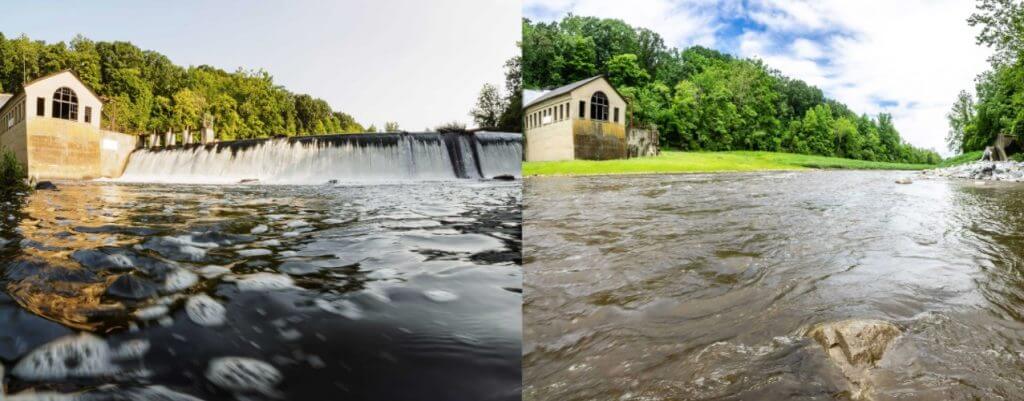Beth Styler Barry
Chester, New Jersey
For more than 20 years, Styler Barry has worked toward watershed education and protection in New Jersey, including work with various stakeholders. She leads the development and implementation of major on-the-ground river restoration projects in the Paulins Kill watershed and leads the NJ Statewide Dam Removal Partnership. Her efforts and accomplishments in restoring the Musconetcong River and Paulins kill are tremendous in scope and impact. Her commitment to river restoration is contagious and she serves as a relentless voice for New Jersey’s rivers and the surrounding inhabitants.
Beth was honored as a River Hero at River Rally 2021.
This interview was conducted by Carly Schmidt on February 26, 2021.
You will be honored as one of our 2021 River Heroes for the full scope of your work in New Jersey. Tell me a bit about yourself and how you came into this type of conservation work.
My personal story starts where I think a lot of folks that do this kind of work starts — which is playing in creeks when I was little. The kids in the neighborhood used to make dams and now I take them out! I had a deep interest in science when I was in school so I went down that track. I got a degree in biochemistry and worked in a pharmaceutical lab for a long time. After being at a pharmaceutical company for a while, I got my master’s in environmental health and safety. I thought that I would use the degree in my pharmaceutical career but it reignited my childhood interest in creeks and rivers.
Around the time when I was having my fourth child, the pharmaceutical company I worked for was going through a merger. I was home for a while, so I decided to start volunteering with the Musconetcong Watershed Association (MWA). I had a lot of mentors to help with this career shift—from the Parks Service to the previous director at MWA—and I was a very eager student. I stayed [at MWA] for 16 years, first as their program administrator and then as the director, and I loved every part of it. I did a lot of education work with school kids, did some water quality testing, finished up the Wild & Scenic designation, and really dove into every aspect of the work.
When I had been at MWA for about eight years, I helped remove my first dam. I like to say that dam removal feels like eating potato chips; you have one, then you need another one and another one. This dam removal was really the first intensive piece of river restoration we did and to see the difference that it made to the river was incredible. Most of the stuff we work on we have to monitor for a decade, but there’s almost no other time you can see immediate benefits than when a dam is removed. It’s both mind-blowing and deeply touching to see how the river behaved a thousand years ago. Over my time at MWA, we wound up removing a total of five dams over eight years. We had developed an expertise for it and saw what it could do for our rivers, so we really pushed those initiatives forward.
After those 16 years, the Nature Conservancy was working on the Columbia dam on the Paulins Kill. They had an opening to lead on a number of different tasks related to the removal of the Columbia dam, which was the largest dam removal in New Jersey. It was a great opportunity with a great organization and so I made the move.

Side by side photos of the Columbia dam pre-removal (June 2018) v one year after the dam came down (June 2019). Today, the river is healthy and free flowing. © Jeff Burian/TNC
Now I am working on two more dam removals on the Paulins Kill with the Nature Conservancy, which will open up 20 miles of mainstem and 40 miles of tributaries. The statewide dam removal partnership allows us to build the kind of strength required to tackle the 1700 regulated dams in the state, as well as hundreds that are not regulated. It’s been an incredible journey that has kept me tied very closely to a love for rivers.
How do you even begin to have that conversation with people about removing a dam and how do you reach out to landowners in that way?
A bunch of partners are working together on this outreach and the website (NJDams.org) has a ton of resources. Presentations at municipal meetings can get heated so it’s great to be able to point to a resource where people can learn about permitting, the ecological benefits of dam removal, and liability. There are a lot of dam owners who, when we approach them, are surprised to learn that they own a dam. So the first step is explaining that.
The second piece of outreach is explaining that landowners have alternative options to managing that dam, and one of those is removing it. But that option also comes with many assumptions. They wonder if the residents upstream will be affected by the dam removal and whether the removal will affect their encampments. The most effective way to answer their questions is to bring them out to a site and show them a successful removal.
Another piece is understanding why people might be interested in a dam removal on their property. Sometimes the ecological reasons are enough but people also want to be rid of the liability.
It sounds like, in addition to ecological benefits, dam removal has huge safety benefits for these communities.
Oh yeah. When these dams were built, they were mini-industries next to a mill. But the Columbia Dam, for example, was a huge hydro plant that was 18 feet high and 300 feet long. The state bought this Dam, which was in the middle of a large wildlife management area. They were encouraging people to visit this place for recreation. And as we see more people using waterways for recreation, we are also seeing dam-related drownings increase.
Where does your commitment to dam removals come from?
I feel so deeply that we owe it to the rivers to undo the damage we’ve done in the last hundred years. When we remove a dam, people celebrate it as being historic, but this history started 13,000 years ago. But we can undo all of that damage. I believe very strongly in the Rights of Nature movement and the wrongness of our laws treating nature as property. And within the Rights of Nature movement is the declaration of the rights of rivers. I believe that rivers have the right to flow and do the things that they’ve been doing for millions of years. And I am reminded of this every time a dam comes out.
It gives me great satisfaction to see dam removal—which was once an extreme restoration practice—become something that is more of a needed practice. That is so apparent through the Statewide Dam Removal Partnership, which gives folks access to the partners and support that they need.
What was it like to secure a Wild & Scenic River Designation for the Musconetcong?
It was very much a grassroots effort. The Musconetcong is a very special river to a lot of communities, so we recruited them to assist in the years-long study to prove outstandingly remarkable value (ORV). The next step was introducing the bill. We worked with our senators to get the bill introduced, which was not easy and the bill was introduced multiple times.
I remember going to bed during the last session of Congress thinking that, once again, the bill didn’t pass. But I woke to a victory email and learned that it passed at 2:00 in the morning. It was a years-long process, the first work on the designation happened in 1993 and the river was designated in 2008. And now that the river is designated, it comes with a cooperative agreement from the Parks Service with some funding associated with it.
What issues are top-of-mind for you these days?
I am focused on continuing to build a statewide partnership. I am also learning more and more about the Rights of Nature, which is more of a personal learning journey at the moment, but I am working to incorporate that into my work on a deeper level. I would love to see these rivers that we’re working so hard to restore truly protected for their own value and not as a piece of property. And, of course, there are a couple thousand more dams in New Jersey so there is plenty of work to be done.







